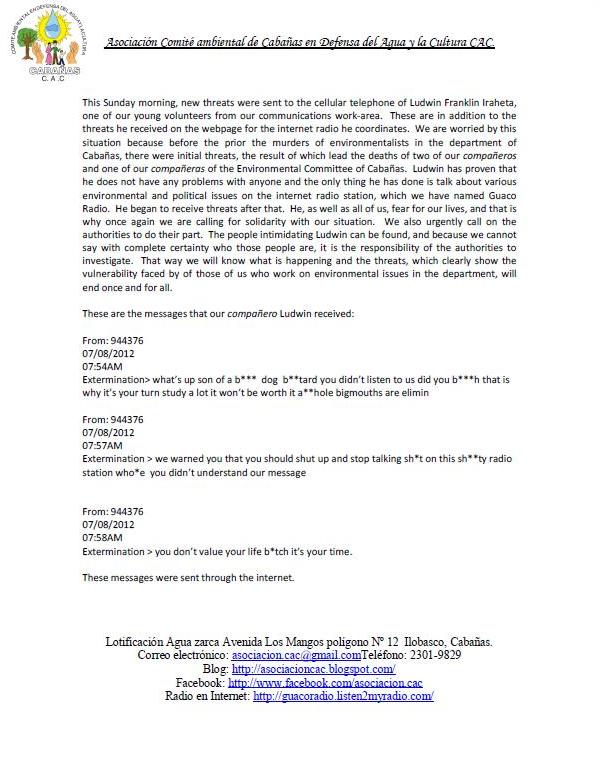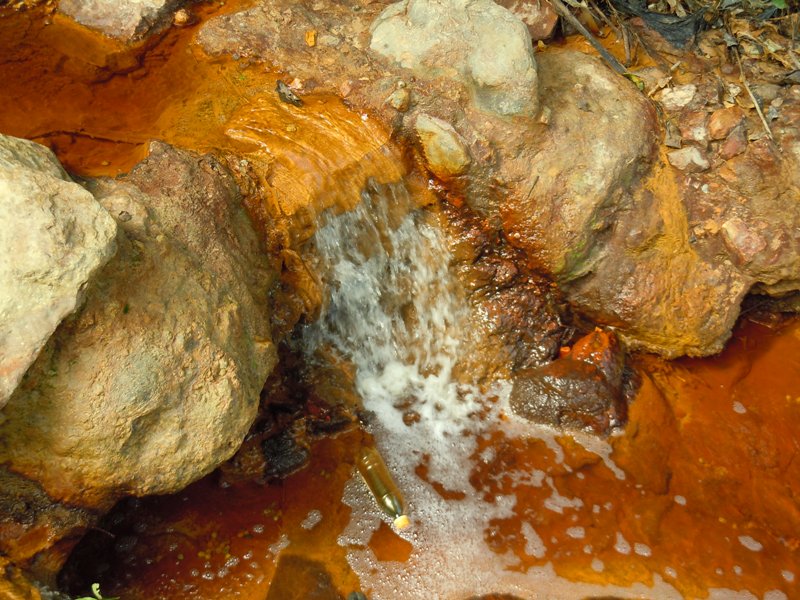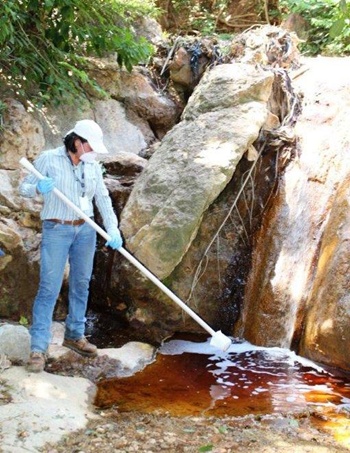- Details
-
Category: Mining and Human Rights
-
Published: Friday, 13 July 2012 18:25
The CAC Report s a New Round of Threats
On the heels of the one year anniversary of the murder of Juan Francisco Duran, the Environmental Committee of Cabañas (CAC) reports new threats towards one of their young volunteers.
Below is the CAC statement documenting the most recent incident.
Here is the original in Spanish and here is documentation of the threats made through the Guaco Radio website (in Spanish).

- Details
-
Category: FTAs & ISDS
-
Published: Thursday, 05 July 2012 14:41
El Salvador loses on three out of four counts, as anti-environment and anti-development case launched under CAFTA drags on
Todd Tucker, June 4, 2012
El Salvador lost three out of four of its major arguments in last Friday’s Pac Rim Cayman LLC v. El Salvador jurisdictional ruling. Even though it narrowly won dismissal of its CAFTA case, the underlying claims will proceed at World Bank-based hearings as a challenge under El Salvador’s domestic Investment Law.
The lowlights?
-El Salvador lost on three out of four counts, and Pacific Rim's attack on El Salvador's mining policies will proceed. The government may still have to pay millions in tribunal and legal costs for the portion that was dismissed.
-CAFTA's extraordinary investment protections kick in for existing investments even without a firm making any new investments after CAFTA went into effect! Government actions that predate CAFTA - but continue after it went into effect
-Government actions that predate CAFTA - but continue after it went into effect – can be a "continuing omission" that can keep governments on the hook years later. In this case, Pacific Rim's mining permit was presumptively denied before CAFTA went into effect, but the firm and the government continued to discuss it and the permit remained not granted to date. Following this logic through, a company’s failure to meet a regulatory requirement in the year 1800 can constitute a “continuing omission” attributable to the government (as if it were a contract) for centuries to come, provided the government is nice enough to continue to talk about it.
-The dismissal of CAFTA jurisdiction was on worryingly narrow grounds: had the firm reorganized its corporate structure so that its pre-existing U.S. corporate entity obtained ownership of the Salvadoran mining interest (rather than Pacific Rim's Cayman subsidiary that owned those assets being reincorporated as a new U.S. entity to pursue the CAFTA case), El Salvador could have been held liable for a CAFTA violation on the basis of a dispute that actually started before CAFTA, just because the governmental authorities were kind enough to keep speaking to the company about their permits.
-Through this narrow dismissal of the CAFTA complaint, the tribunal practically laid out a road map for future aggressive nationality planning companies to abuse the investor-state system to attack environmental policies.
To read the rest of the article

- Details
-
Category: FTAs & ISDS
-
Published: Thursday, 05 July 2012 14:27
Mining Firm Doubles Up On Law Firms in Quest for Pot of Gold
Sarah Anderson, IPS Global Economy Project Director
Posted: 06/06/2012 5:50 pm
A Canadian mining company has cleared a major legal hurdle in their quest to exploit gold in El Salvador. In a celebratory press release, the firm, Pacific Rim, quoted lawyers from two Washington, DC law firms that are representing it in the case.
I guess having one legal powerhouse behind you just isn't enough when a major pot of gold is at stake. And so far, the investment appears to be paying off.
Pacific Rim is suing the government of El Salvador, demanding more than $77 million in compensation over the government's denial of a permit for a gold mining project. The government acted in response to strong public concerns that the project could contaminate a river that is the drinking water source for more than half the country.
The World Bank tribunal hearing the case, in a classic cowardly maneuver, put the word out late Friday that they planned to advance the case past the jurisdictional phase and start hearing arguments about the merits.
The Pacific Rim release quotes one "extremely pleased" lawyer from Weil, Gotshal & Manges and another from Crowell & Moring who called the ruling a "great development." The continuation of the case makes for more billable hours. According to the Wall Street Journal, lawyers at Weil, Gotshal & Manges make as much as $1,045 per hour. GDP per capita in El Salvador: $3,426.
Read the rest of the article here

- Details
-
Category: FTAs & ISDS
-
Published: Thursday, 05 July 2012 14:14
Today’s Trivia Quiz: How Global Mining Corporations Are Able to Undermine Democracy
Posted By Triplecrisis On June 28, 2012 @ 9:00 am In Guest Bloggers | No Comments
Robin Broad, guest blogger
Today’s trivia category is how global mining corporations undermine democracy.
First a bit of background. The way licensing for mining works is that a company first gets an “exploration license.” With that license, that company gets the right to explore – or test – the area to get a better sense of the extent of the gold or whatever the relevant mineral is. After that, the company can move on to apply for an “exploitation” or “extraction” license — that is, an actual mining license. Different countries have different requirements for both licenses but typically a company would be asked to present an environmental impact assessment and a feasibility assessment among other things.
To make this easier, let’s use the hypothetical case of a gold-mining company that is seeking to mine in another country.
Are you set? Ok, so here’s today’s trivia question: You are a foreign gold-mining company. You have already received an “exploration license” to mine in another country. You want to get an “exploitation license” so that you can start the actual mining. However, that country’s government has not approved your environmental impact statement and you have not yet submitted a feasibility assessment. Therefore, your best chance at getting that “exploitation license” is to:
(a) Just redo the environmental impact statement.
(b) Just do the feasibility assessment.
(c) Carefully follow the country’s written requirements and submit everything that is required.
(d) Ignore the country’s written requirements and find some friendly government official who is willing to meet with you.
And (drum-roll, please) the answer is: (d). That’s right: Ignore the country’s written requirements and find some friendly government official who is willing to talk about the possibility of getting a mining license.
Read the rest of the article here

- Details
-
Category: Commerce Group
-
Published: Thursday, 05 July 2012 11:54
Investigations into pollution in the San Sebastian River (LPG)

Yesterday a delegation of specialists collected samples from the river
Written by Ángela Alfaro
Tuesday, July 3, 2012 00:00
Translated by Jan Morrill
Original Version in Spanish
Specialists from the Ministry of the Environment and Natural Resources (MARN) took water samples from the San Sebastian River, in Santa Rosa de Lima, contaminated by heavy metals, apparently, the product of substances used during mining activities that were carried out in the area.
The samples were taken within a perimeter of 2.5 km from the river, in the area called El Comercio.
The copper colored water samples will be analyzed in a MARN laboratory, said Roberto Avelar, from the Office of Environmental Compliance of that government agency.
The copper colored stream of water flows from one of the tunnels dug into the high part of the mountain, but the origin of the water has not been determined, explained Avelar.
Locals say that they are used to seeing the water that color, but that they don’t use it for bathing, nor for cleaning their homes, except during the rainy season when the water level rises.
The trip was accompanied by staff from the Firefighters, the National Civilian Police and the Ministry of Health.
Samples Taken
During the visit, specialists from the Firefighters opened two metallic containers that were stored on private property, by a gold mining company that operated in the area and which stopped mining because it permits has been revoked.
In one of the containers that the Firefighters opened 23 barrels of ground powder were found that are presumed to be sodium cyanide. The second container had black bags of ferrous sulfate.
Both are chemicals used in the gold extraction process.
The person in charge of the storage area, who asked to remain anonymous, said that both containers had been there since 2009.
At first glance the chemicals hadn’t had any contact with the ground, due to the fact that they were protected by locks and surrounded by a perimeter wall.
These samples will also be analyzed by the Ministry of the Environment to determine if there was pollution.
Mining
Since the end of last year the Municipal Mayor’s Office of Santa Rosa de Lima has been reporting mining, operations for which they suspect heavy machinery and explosives were used.
In November the Environmental Committee from this community forced the suspension of artisanal gold excavation.
A phone call tipped-off authorities that an “unknown substance” was polluting the Santa Rosa River, in the town of San Sebastian.
At that time the community reiterated that the miners didn’t have authorization to use machines or explosives to extract gold from the San Sebastian mines.
The authorities themselves confirmed that at that moment they didn’t take water samples nor did they inspect to see if there were animals that had died from the pollution.
The Investment and Trade Research Center (CEICOM, in Spanish) asked last April that the government ban any type of mineral exploitation in the country, due to the high levels of heavy metals found in the soil.
The request was accompanied by the results of studies done of the soil in the mining regions, where CEICOM found high levels of heavy metals. Among the findings is the presence of substances like radioactive gases, sulfuric acid, cyanide and mercury, in toxic levels for public health.
- Details
-
Category: Commerce Group
-
Published: Thursday, 05 July 2012 11:35
Investigations into Pollution in the San Sebastian River
The containers analyzed by MARN presumably contain cyanide and ferrous sulfate
By Gloria Morán
Translation by Jan Morrill
Original Version in Spanish
SAN SALVADOR – The color of the water seems to get worse as the current advances, beginning as an almost clear color until it becomes a strong brown color, which smells of rust and where the rocks which are immersed in the water also seem to have changed color over time. This is the reality for the San Sebastian River in La Union.

Pollution of rivers in El Salvador is well known, but this river in particular has caught the attention of environmental activists and, now, the Ministry of the Environment and Natural Resources (MARN) because of the heavy metal contamination supposedly coming from the top of the San Sebastian Mountain, which used to be the site of mining operated by the multinational corporation Commerce Group since 1968.
However, according to a report presented by researcher Flaviano Bianchini, mining operations by other companies date back as far as 1904.
On the edge of the river there are a number of houses. Living there would be a pleasant experience if the pollution from the river weren’t such a dangerous contrast.
Also, close by one can find livestock animals, such as cows, chickens and pigs, all of which consume water from the river. The pigs freely bathe themselves in river water.
Some locals wash their clothes, their cooking utensils and drink water from this river, especially in the rainy season when the current hides the brown color of the water. They think, “if the water is clear, there is no pollution.”
The river accumulates all the acid mine drainage, especially the drainage washed down in the rainy season of metals leaching from the mountain, exactly where the mine was operating.
The Investigation
The MARN began its investigations after receiving complaints from the population which was concerned about the presence of containers holding high risk chemical substances near the top of the mountain.
There were two yellow containers, apparently new, that are secured by two locks on each container and around the containers there was a small brick wall. In one of the containers there were 23 barrels, presumably full of sodium cyanide and the other held black bags of ferrous sulfate, both of which are chemicals used in the gold extraction process.
The MARN took samples of both the chemicals found in the containers as well as the river water, within a perimeter of exactly 2.5 km of the San Sebastian River. The containers were open by staff from the Firefighters of La Union.
In spite of appearance that containers and even the locks had recently arrived, the person in charge of the site, who asked not to be identified, said that they have been there since 2009 and that they are the property of the Commerce Group, a company that brought them to the site with the hope of using them if the Government issued their permits to mine.
Roberto Avelar from the Office of Environmental Compliance of the MARN said he was not sure of the date when they will finish the investigation, but stated that when it’s over they will determine what to do with containers, what measures they will take regarding the river’s pollution and how to protect the lives of the locals.
Artisanal Mining
There is a narrow but long, humid and dark tunnel that is held up by small wooden beams. Young men who live in the town of San Sebastian work in this tunnel. There is not just one tunnel, but five more have also been counted.
Any human who enters in this tunnel and is not prepared for the humidity, the darkness and the lack of air won’t last five minutes before running in search of the exit.
One of the young men who work here said that the workers go in four or five times a day to bring out rock or soil that is then cleaned in an artisanal process to extract the gold. They are called “güiriceros” (which means a foragers).
Their tools are pickaxes, shovels, gas or battery operated lamps, a wheelbarrow, and the willingness to do a dangerous job without adequate safety measures.
There are four young men who aren’t more than 22 years old but no younger than 15 who work in this tunnel. Laughing and joking they said they are used to going in and out of the tunnel and that “we’re used to it.” They are aware of the danger but are not worried about it, this is their job, and that is how they survive.
The Procedure
In 2011 ContraPunto had the opportunity to witness the artisanal process for cleaning rock extracted for mining, and on that occasion a worker, who asked not to be identified, stated that buying soil and finding gold is like playing the lottery, because there are times when the process pays off and times when it doesn’t. He explained that there have been times when he has gone two years without finding any gold.
When the rock is given to workers who process the soil they go through the labor-intensive task of first pulverizing the dirt, which then is called clods. Then it is molded into balls the size of a baseball and which are put in the sun to dry.
The dirt is crushed in an artisanal grinder that is operated by a young man who spends more than five hours moving a double ended stick, that is “v” shaped allowing him to hold on to it, in circles. The lower part of the stick has a ball of cement attached that weighs about 150 pounds. This tool has a deep base where the soil is placed and this is how the work of pulverizing the soil begins.
When the balls of soil are dry, they are put in an oven where some chemicals in the soil are burned off. According to the worker who does the processing, this is to improve the clods and find more gold.
After the oven, the balls are placed again in the grinder where they are mixed with water and mercury, the chemical that separates the gold from other elements. “Even though the mercury leaves the gold white, once it is put in the oven it takes on a lovely color because it is pure 24 karat gold,” said the worker.
He also stated that artisanal mining incurs less risk than industrial mining, because even though the workers have a safety protocol, the toxic emissions from the chemicals they use are much stronger and more dangerous because they work at greater depths within the mountain, apparently around 400 meters deep.
The artisanal mining that is currently operating in the area would still entail risks, but to a lesser degree, due to the fact that this activity does not use chemicals, like cyanide, and would not cause large scale pollution of the environment nor humans.






